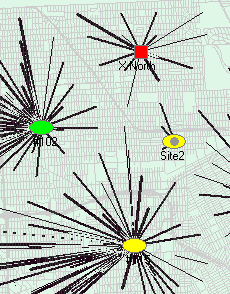  |
|
Strategic Retail Location
2—Retail Site Selection Models
 |
CLEO allocates demand
to existing
and
planned stores to estimate
sales. Coloured
centres are stores. Lines show allocation
and volume of dominant flow from
each
origin. |
CLEO leaves behind simplistic circular
trade area
concepts, and instead applies two potent families of models that
exploit the analytical power
of modern GIS and operations research. One is the spatial
interaction models (or gravity models) that predict shopping
behaviour. CLEO predicts the likely customer
expenditure at one or more existing or planned locations, belonging to
the client store chain or
competing chains. A number of retail forecasting systems do this.
Now's when CLEO distinguishes itself and takes you
two
critical steps further. First, at the heart of
its engine are a pair of location
allocation models, designed to
rationalize and to optimize your network of stores relative to
the competition.
Say there are 12 sites available, and you wish to
develop four
of them. Which four would
work best with your existing configuration, and hem in the competition
to your advantage? Which
existing outlets should be closed to make way for the new locations?
Recall the encircling strategy in the
illustration on the previous
page. CLEO
evaluates hundreds or thousands of
permutations and selects the optimal set of
4, 5, 6 or whatever number of locations you like, to serve the market
best.
Maybe you're not sure where in the city to search
for new
sites. How do you know the available sites are in promising locations?
Turn on Scout mode, and CLEO scans the territory and recommends the
best
neighbourhoods in which to look. For one, two or ten sites.
Next, the models are tied into a decision support
system that
evaluates scenarios and looks at the balance of competing objectives.
Performance
measures appear in tables and charts, and maps show who shops where,
how neighbouring stores compete for business, and which markets remain
poorly served
or at risk from new competing offerings. Extensive tabular reports show
performance
details and catchments for each store, and give you numeric measures of
competition and
cannibalization, systemwide and for each store.
Bottom line: before you make a decision on the
important
matter of store location, you have all the pertinent information at
your disposal. You know the theoretical optimum, and if you choose not
to go with it, you know how far off you are.
Despite its technical sophistication, CLEO
recognizes and
accommodates the important
contributions of local experts in the location decision. It is designed
for the
decision maker rather than the technician. Its intricacies are
mostly transparent,
yet it offers exceptional control over model choices and parameters,
for those
who prefer to dig deep.
|